Complete Solutions to EXERCISE of chapter QUADRILATERALS of Class 9 book with complete answers and questions
| Class 9 | MATHS |
| Chapter | QUADRILATERALS |
| MODERN PUBLICATION | EXERCISE |
| Number Of Questions | 100 |
| Academic Year | 2023-24 |
Three angles of a quadrilteral are respectively `50^@` and `110^@` and `100^@` . Find the fourth angles.
02:29View SolutionThe angle of a quadrilateral are in the ratio 2: 4: 5: 7. find the angles.
03:03View SolutionIn the quad. ABCD is a point inside it. Find that OA+OB+OC+OD>AC+BD.
04:37View SolutionIn the fig. `BLbotAC` and `DMbotAC`. If BL=LM prove that AC bisects BD
 02:09View Solution
02:09View SolutionIn the fig. ABCD is a square and `anglePQR=90^@` PB=QC=DR, prove that:QB=RC
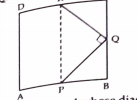 02:23View Solution
02:23View SolutionIn the fig. ABCD is a square and `anglePQR=90^@` PB=QC=DR, prove that:PQ=QR
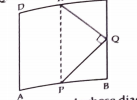 03:36View Solution
03:36View SolutionIn the fig. ABCD is a square and `anglePQR=90^@` PB=QC=DR, prove that:`angleQPR=45^@`
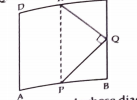 05:36View Solution
05:36View SolutionABCD is a quadrilateral whose diagonals AC and BD intersect at O, prove that:
(AB+BC+CD+DA)>(AC+BD)05:14View SolutionABCD is a quadrilateral whose diagonals AC and BD intersect at O, prove that:
(AB+BC+CD+DA)>2(AC+BD)04:36View SolutionA diagonal of a rectangle is inclined to one side of the rectangle at `25^@`. The acute angle between the diagonals is
03:37View SolutionIn a parallelogram, prove that sum of any two consecutive angles is `180^@`.
03:30View SolutionIf an angle of a parallelogram is two thid of its adjacent angle, find the angles of the parallelogam.
02:08View SolutionIn the fig. ABCD is a parallelogram in which `angleDAB=60^@` and `angleDBC=80^@` find `angleCDB` and `angleADB`
 02:52View Solution
02:52View SolutionIn the fig. ABCD is a parallelogram in which `angleBAO=35^@`, `angleDAO=40^@` and `angleCOD=105^@`

find that:`angleABO`?02:12View SolutionIn the fig. ABCD is a parallelogram in which `angleBAO=35^@`, `angleDAO=40^@` and `angleCOD=105^@`

find that:`angleODC`?02:07View SolutionIn the fig. ABCD is a parallelogram in which `angleBAO=35^@`, `angleDAO=40^@` and `angleCOD=105^@`

find that: `angleACB`01:24View SolutionIn the fig. ABCD is a parallelogram in which `angleBAO=35^@`, `angleDAO=40^@` and `angleCOD=150^@`

find that:`angleCDO`02:23View SolutionThe diagonals of a rhombus are perpendicular to each other .
04:12View SolutionThe diagonals of a rectangle ABCD meet at o and `angleBOC=44^@` and find `angleOAD`.
02:32View SolutionABCD is a rectangle with `angleABD=40^@` determine `angleDBC`.
01:26View SolutionThe sides AB and CD of a parallelogram ABCD are bisects at E and F. prove that EBFD is parallelogram.
05:24View SolutionTwo adjacent angles of a parallelogram have equal measure. Find the measure of each of the angles of the parallelogram.
01:44View SolutionThe lengths of the diagonals of a rhombus are 10 cm and 8.2 cm .Its area will be :
01:46View SolutionIn the fig. ABCD is a square M is the mid point and `PQ bot CM` meets AD at and CB produced prove that
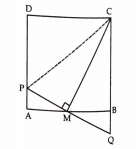
PA=BQ?02:59View SolutionABCD is a square M is the mid point of AB .`PQbotCM`. PQ meets AD at P and CB at Q prove that
CP=CQ04:20View SolutionABCD is a parallelogram. L and M are points on AB and DC respectively and AL = CM. Prove that LM and BD bisect each other.
05:12View SolutionIn Fig. .
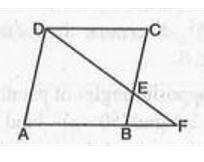
ABCD is a parallelogram and E is the mid-point of side BC. If DE and AB, when produced meet at F, prove that AF = 2AB.06:17View SolutionIn the fig. ABCD is a parallelogram and X,Y and Z the points on diagonal BD such that DX=BD prove that CXAY is a parallelogram.
 03:49View Solution
03:49View SolutionIn the fig ABCD is a parallelogram in which E and F are mid points of AB and CD respectively. Prove that the line segments CE and AF intersect diagonal BD
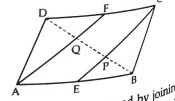 05:43View Solution
05:43View SolutionProve that the figure formed by joining the points of the adjacent sides of a quadrilateral parallelogram.
03:49View SolutionProve that the figure formed by joining the mid-points of the pairs of consecutive sides of a quadrilateral is a parallelogram.
02:25View SolutionIn triangleABC, AD is the median through A and E is the mid point of AD. BE is produced so as to meet AC in F. prove that `AF=1/3AC`
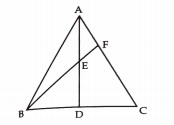 04:14View Solution
04:14View SolutionABCD is a parallelogram. P is any point on AD, such that `AP = 1/3AD` and Q is a point on BC such that `CQ = 1/3AD` . Prove that AQCP is a parallelogram.
02:36View SolutionP is the mid point of side AB of a parallelogram ABCD. A line through B parallel to PD meets DC at Q and AD produced at R. prove that
AR=2BC.04:54View SolutionP is the mid point of side AB of a parallelogram ABCD. A line through B parallel to PD meets DC at Q and AD produced at R. prove that
BR=2BQ.02:57View SolutionProve that the line joining the mid points of the diagonals of a trapezium is parallel to the parallel sides of the trapezium.
06:19View SolutionIn the fig. two points A and B in on the same side of a line XY. If `ADbotXY, BEbotXY` and C is the mid point of AB. Prove that CD=CE
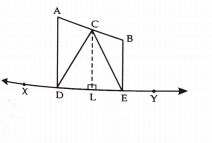 03:41View Solution
03:41View SolutionIn the fig. ABCD is a trapezium in which AB||DC and AD=BC. IF P,Q,R,S are respectively the mid points of BA,BD and CD,CA, then show that PQRS is a rhombus.
 05:25View Solution
05:25View SolutionABCD is a trapezium in which AB||DC and let E be the mid point of AD. Let F be a point on BC such that EF||AB. Prove that

F is mid point of BC.02:31View SolutionABCD is a trapezium in which AB||DC and let E be the mid point of AD. Let F be a point on BC such that EF||AB. Prove that

`EF=1/2(AB+DC)`05:59View SolutionIn the fig points M and N divide AB of triangleABC into three equal parts. Line segments MP and NQ are both parallel to BC and meet AC in P and Q respectively. Prove that P and Q divide AC nto three equal parts
 03:09View Solution
03:09View SolutionProve that any line segment drawn from the vertex of a trianlge to the base is bisected by the line segment joining the mid points of the other sides of the triangle.
05:20View SolutionThe figure obtained by joining the midpoints of the sides of a rhombus, taken in order, is
04:06View SolutionDiagonals of the parallelogram bisect each other at right angles .
02:26View SolutionName the quadrilateral formed in which two parallel of adjacent sides are of the same length.
01:18View SolutionIn a quadrilateral PQRS, `angleP+angleS=180^@`. Name the type of quadrilateral it is?
01:57View SolutionIn a parallelogram PQRS, write the sum angles of P and Q.
01:15View SolutionABCD is a rectangle with `angleBCA=34^@` find `angleDBC`.
03:49View SolutionThe perimeter of a parallelogram is 24 cm. if the large side measures 7.5 cm, what is the measure of shorter side?
01:17View SolutionIn quadrilateral ABCD, AP and BP are bisector of `angleA` and `angleB` respectively, then find the value of x
 03:03View Solution
03:03View SolutionIf three angles of a quadrilateral are `110^@,65^@` and `105^@` then find the measure of the fourth angle.
01:20View SolutionOpposite angles of a quadrilateral ABCD are equal. If AB=4 cm determine CD.
01:20View SolutionCan all the angles of a quadrilateral be right angles? Give reasons for your answer.
01:26View SolutionIn a parallelogram PQRS, if `angleS=125^@`, find the measure of `angleP`.
01:24View SolutionIf the angles of a quadrilateral are in the ratio 3:5:9:13 , then find the measure of the smallest angle.
01:32View SolutionIn a parallelogram PQRS, `angleP=(3x-20)^@,angleQ=(y+15)^@,angleR=(x+40)^@`, then find the values of x and y.
02:43View SolutionIn the fig. PQRS is a trapezium. Find the values of x and y
 01:21View Solution
01:21View SolutionIn the fig. ABCD and AEFG are the parallelogram if `angleC=58^@`, find `angleF`
 01:30View Solution
01:30View SolutionPQRS is a parallelogram. Find the values of x and y
 01:24View Solution
01:24View SolutionDiagonals of a parallelogram ABCD intersects at O. if `angleBOC=90^@` and `angleBDC=50^@`. Then find `angleOAB`.
03:10View SolutionIn the fig. ABCD is a rectangle in which diagonal AC is produced to E. if `angleECD=146^@` if find `angleAOB`
 03:54View Solution
03:54View SolutionABCD is a trapezium with parallel sides AB = a cm and DC = 6 cm E and F are the mid-points of the non-parallel sides. The ratio of ar (ABFE) and ar (EFCD) is
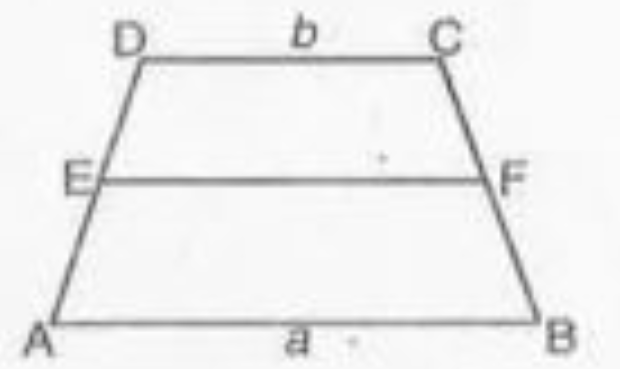 06:10View Solution
06:10View SolutionTrue/false
If all the sides of quadrilateral are equal, then it is a rhombus.00:50View SolutionTrue/false
Diagonals of a paralllelogram are perpendicular to each other.01:08View SolutionTrue/false
All the four angles of a quadrilateral can be obtuse angles.01:13View SolutionTrue/false
Diagonals of a rhombus are perpendicular but unequal.01:07View SolutionThe figure formed by joining the midpoints of the consecutive sides of a quadrilateral is ............... .
04:10View SolutionTrue/false
If three angles of quadrilatera are `30^@,80^@,110^@` then the fourth angle is `120^@`.01:27View SolutionIn a parallelogram, sum of any two adjacent angles is `180^@`.
01:41View SolutionTrue/false
Consecutive angls of a parallelogram are complementary.02:03View SolutionTrue/false
If in a quadrilateral one pair of opposite sides are parallel, the quadrilateral is a rhombus.01:49View SolutionTrue/false
If one angle in a parallleogram is a right angled, then it is necessary a rectangle.02:14View SolutionFill ups
In a parallelogram the opposite sids are……………. .01:13View SolutionFill ups
A square, rectangle and rhombus are……………. .01:22View SolutionFill ups
In a parallelogram ……………bisect each other.01:05View SolutionFill ups
A quadrilateral is a parallelogram if both pairs of opposite angles is………………. .01:08View SolutionFill ups
If one pair of opposite sides are equal and parallel, then the figure is……………00:48View SolutionFill ups
Consecutive angles of a aprallelogram are…………. .01:36View SolutionFill ups
If consecutive sides of a parallelogram are equal, then its necessarily a…………….. .01:33View SolutionThe figure formed by joining the midpoints of the consecutive sides of a quadrilateral is ............... .
04:10View SolutionThe bisectors of angles of a parallelogram from a :
05:07View SolutionThe angles of a quadrilateral are in the ratio `3 : 4 : 5 : 6`. The respective angles of the quadrilateral are :
01:59View SolutionIn a quadrilateral ABCD, if AO and BO are the bisectors `angleA` and `angleB` respectively, `angleC=70^@` and `angleD=30^@` then `angleAOB`=
03:23View SolutionThe figure formed by joining the midpoints of the consecutive sides of a quadrilateral is ............... .
04:10View SolutionThe figure formed by joining the mid points of the adjacent sides of a rectangle is
01:35View SolutionThe figure formed by parallelogram is `24^@` less than twice the smallest angles, then the largest side angle of the paralellogram is
02:31View SolutionFind the measure of all the angles of a parallelogram, if one angle is `24^@` less than twice of the smallest angle.
04:16View SolutionThe consecutive sides of a quadrilateral have
01:12View SolutionWhich of the following quadrilateral is not a rhombus?
01:22View SolutionThe bisectors of any two adjacent angles at a parallelgoram intersect is
04:18View SolutionThe figure formed by joining the mid points of the adjacent sides of a paralellgoram s
01:09View SolutionThe figure formed by joining the mid points of the adjacent sides of a paralellgoram s
01:09View SolutionIn one angle of a prallelogram is `24^@` less than the smallest angles, then the measure is largest angle of the parallelogram is
01:55View SolutionABCD is a parallelogram and E and F are the centroids of triangle ABD and BCD respectively then EF=
05:39View SolutionIn Fig. .

ABCD is a parallelogram and E is the mid-point of side BC. If DE and AB, when produced meet at F, prove that AF = 2AB.06:17View SolutionIf the degree measures of the angles of quadrilateral are 4x,7x,9x and 10x what is the sum of the measures of the smallest angle are largest angle?
03:24View SolutionThe diagonal AC and BD of a rectangle ABCD intersect each other at P. if `angleABD=50^@` and `angleDPC`=
03:21View SolutionABCD is a rhombus such that `/_ACB = 40^@`. Then `/_ADB` is
03:52View SolutionDiagonals of a parallelogram ABCD intersects at O. if `angleBOC=90^@` and `angleBDC=50^@`. Then find `angleOAB`.
03:10View SolutionABCD is a trapezium in which `AB || DC`. M and N are the mid-points of AD and BC respectively. If AB = 12 cm, and MN = 14 cm, find CD.
02:08View Solution
EXERCISE questions and complete solutions for chapter QUADRILATERALS of MODERN PUBLICATION of Class 9
